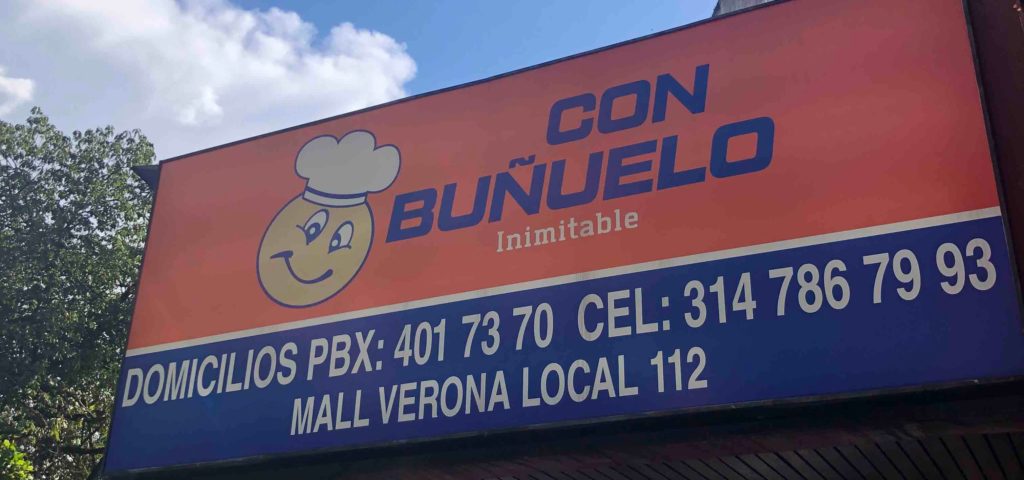TLDR? The buñuelo is a traditional Colombian dessert, usually eaten at Christmas time and stuffed full of jam, chocolate, or caramel.
Colombia’s cuisine is quite distinctive. And, it has no shortage of unique culinary items that the culture has engineered over time. One of the most notable of Colombia’s snack foods is the strange but enticing bundle of deep-fried and spongy goodness known as the buñuelo.
Once you catch sight of a buñuelo and stuff it in your mouth, you’ll find yourself in the middle of an experience not quite like anything else. This is because the buñuelo is a unique little morsel that’s a little bit unlike anything else.
Here’s a quick summary of all the relevant info on this tasty little treat. Plus, I’ve thrown in a couple of places where you can procure some for yourself!
What Exactly Is A Buñuelo?

If you’re unfamiliar with what a buñuelo is, you might just look over them without knowing exactly what you’re looking at.
Once you notice them, however, you’ll quickly observe that buñuelos are a nearly ubiquitous foodstuff. You’ll find them all over in the markets and working-class neighborhoods of Medellin and the rest of Colombia.
The buñuelo has a global history as a traditional food item, with a ton of regional and national variations in how the treat is prepared.
The Colombian buñuelo is distinct in itself as a delicious and dense heavy ball of fried dough. It is traditionally consumed in the morning with coffee.
It’s not typically prepared sweetly, so think of a doughnut hole with a bit of a savory inflection. If you’re feeling skeptical, then I would say that the coffee pairing makes all the difference!
The History of The Buñuelo
/cloudfront-us-east-1.images.arcpublishing.com/elespectador/ANECDCG42NCWHD3BFSMWL67K5Q.jpg)
The buñuelo’s origin can be traced way back to the Spanish roots of Latin American culture. The buñuelo can be enjoyed in that country as well, albeit in a slightly different form.
Given that the Spanish colonial empire was so vast, you can find different iterations of the buñuelo across the world. It appears as far as Africa and the Mediterranean, the Philippines, and Israel.
The buñuelo is attributed originally to an ethnic group in Spain known as the Moriscos. The Moriscos would prepare buñuelos in similar ways to what one can enjoy today. Although, they would often flavor the dough balls with a distinctive Anise aroma.
Buñuelos carry distinctive cultural attributions where they are consumed. Many groups consume them almost ritualistically on holidays. This is a tradition amongst the Sephardic Jews, for example.
In Colombia and Latin America, they are oftentimes seen as a symbol of good luck. This contributes to the iconography of the treat that you’ll see around. The buñuelo is often wearing an almost manic disposition as a bringer of good tidings and positivity.
A Food of the People

The extensive presence of the buñuelo worldwide is party economical. Buñuelos are quite cheap and contain a fairly massive amount of calories for such a small item of food.
I suppose you could chalk it up to the massive deep fat frier that they’re prepared in!
I even found myself that after some time in Colombia, I would start craving the delectable treat in the morning time. Especially if it came paired with some delicious Colombian coffee!
Treating myself to a buñuelo came with no guilt, however, because they’re typically so incredibly cheap. It came as no problem to chow some down and be set for the rest of the day due to their incredibly high-calorie count.
Once you’re on team buñuelo, you’ll probably start to notice that they’re one of the most common food items you’ll see local Colombians chowing on. This is especially true if you ever spend time in a working-class Colombian neighborhood.
Places To Eat A Buñuelo

If all of this information about buñuelos has got you interested in trying one for yourself, I’m happy to inform you that you’re in luck. This is because you’re going to be able to find one pretty much no matter where you end up in the city.
The treat is so popular that it’s a staple of most people’s diets. So, pretty much no matter where you’re staying or living, there’s going to be some around.
That being said, there are a couple of restaurant chains in Medellin and the rest of Colombia that specialize in the preparation of these tasty morsels.
I should mention that buñuelos are so ubiquitous that I found that the ones that I purchased from the specialty places weren’t necessarily much better than ones that I would find just about anywhere else.
Your best bet in my opinion is to keep an eye out for your local bakery. Those places will probably have the expertise needed to deep fry their buñuelos to perfection.
Sabaneta and It’s Buñuelos

One area in Medellin that has been noted for having especially great buñuelos is the southern suburb known as Sabaneta.
Sabaneta is a bit of a trek south from the more central parts of Medellin. It lies just underneath the area known as Itagui. You can read a guide about Itagui here!
Since it’s a bit out of the way, you might only end up deciding to take the journey if you consider yourself to be a true seeker of Medellin’s greatest buñuelos!
Once you’re in the Sabaneta area, one spot that has been noted as having the best buñuelos available is El Peregrino. But, many of the other buñuelo joints near the Parque de Sabaneta are also considered some of the best in the region!
Another Example of Colombia’s Unique Culinary Heritage
Colombia has a rich and unique culinary heritage that can be found in every corner of the country.
It’s in the markets, the restaurants, and the homes of the people who live there, just waiting to be discovered and chowed upon.
Buñuelos have been one of my favorite discoveries in my time down here, and I’m hoping that the readers will find them to be just as enticing.
If you like this blog, you might like the Casacol Instagram page to keep up with all the new articles. Anything we need to update or correct? Care to contribute? Email us at blog@casacol.co.







